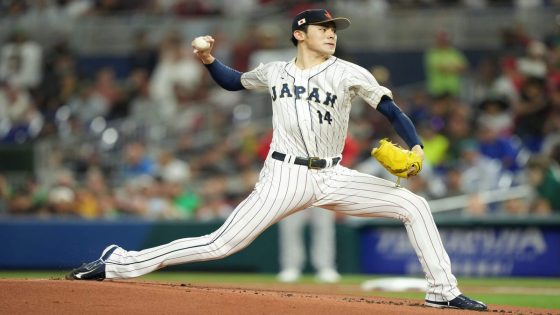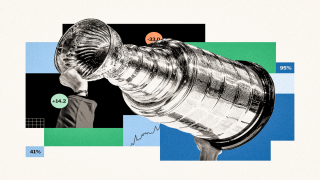The first bombshell of Major League Baseball’s offseason landed Saturday when the Chiba Lotte Marines announced 23-year-old pitching phenom Roki Sasaki will be able to sign with an MLB club this winter.
“I will do my best to climb up from a minor-league contract and become the best player in the world,” Sasaki said in a statement translated by Yakyu Cosmopolitan, “so I have no regrets about my one and only baseball career and can live up to the expectations of everyone who has supported me so far.”
Here’s all you need to know about Sasaki, his contract situation and his electrifying stuff.
Is ‘best player in the world’ really in the range of outcomes?
So long as his countryman Shohei Ohtani is active, Sasaki will have a hard time claiming that title. But there’s no question he has one of the best right arms in baseball. Major-league evaluators have scouted Sasaki since he was a teen in Ofunato, Japan, possessing a triple-digit fastball, a vanishing splitter and an incredible nickname: the Monster of the Reiwa Era.
In 2022, Sasaki threw a 19-strikeout perfect game for Chiba Lotte in which he registered 13 consecutive strikeouts. In his next start, Sasaki tossed eight perfect innings with 14 strikeouts before being pulled.
Once Sasaki began blowing the doors off Randy Arozarena and Alex Verdugo in the 2023 World Baseball Classic, much of the wider baseball world started counting down to his eventual arrival stateside.
Sasaki, who stands a lanky 6 feet 2, is not yet a finished product. “But there’s not many people in the world who are more talented,” an MLB club official said. Sasaki had a 2.10 ERA over four seasons in Nippon Professional Baseball, the top baseball league in Japan. This year, injuries and declines in velocity, stuff and strikeout rate raised questions, but Sasaki remains immensely desirable. Not only because of his youth (only six months older than Paul Skenes) and arm talent (“He reminds me of Jacob deGrom,” an industry source said.) but also because he’s the only top-five free agent all 30 MLB teams can afford to sign.
How much will signing Sasaki cost?
Shockingly little, in modern-day baseball figures.
Most Japanese stars who jump to the majors do so after turning 25, when they still must go through a posting system — in which their NPB club receives a release fee from the signing MLB club — but can sign a big-money major-league deal. Yoshinobu Yamamoto did this last offseason, signing with the Los Angeles Dodgers for $325 million over 12 years while the Dodgers paid his former club, the Orix Buffaloes, about $50 million.
Sasaki’s situation is far more like Ohtani’s than Yamamoto’s.
A player leaving NPB before 25 is considered an international amateur free agent and permitted only to sign a minor-league deal with a bonus paid from the team’s international bonus pool. (For 2025, those pools range from $5.1 million to $7.6 million.) Ohtani was 23 when he signed with the Los Angeles Angels for $2.3 million. The Angels received six years of contractual control for Ohtani — three years of minimum salary, three years of arbitration — before he reached free agency. Had Ohtani played two more years in Japan, his initial MLB contract would have been much more like Yamamoto’s. The same is true for Sasaki.
Why wouldn’t Sasaki wait until he can sign a megadeal?
The simplest answer is he’s ready to prove himself against big leaguers.
When The Washington Post’s Chelsea Janes visited Japan earlier this year, Chiba Lotte outfielder and former Pittsburgh Pirates top prospect Gregory Polanco said of Sasaki, “He asks me about (the big leagues) every day. I go in there, and he’s joking around: ‘I’m going to this (MLB) team, I’m going to that (MLB) team!’ He’s so ready to go.”
Sasaki might also anticipate the endorsements he’ll get playing in the majors will make up for his effectively delaying his first true MLB free agency until the 2030-31 offseason, when he’ll be newly 29.
Sasaki reportedly asked Chiba Lotte to post him last year, after he had a 1.78 ERA in 91 innings. The club chose to hold on to him for another season. Now, they are willing to make him available to MLB clubs. Chiba Lotte leaves tens of millions of dollars on the table by letting Sasaki depart now rather than in 2026. When Ohtani signed in 2017, NPB clubs could set their release fee as high as $20 million — the number the Angels paid the Nippon-Ham Fighters. But the release fee is now determined as a percentage of the guaranteed value of the contract; for minor-league contracts, the signing team will pay the NPB club just 25 percent of the signing bonus.
Why is Chiba Lotte letting Sasaki go now when the release fee is so small?
It does not make financial sense. The way Chiba Lotte officials explained it Saturday, it was a matter of respecting Sasaki’s wishes to pitch in the majors.
Club executive Naoki Matsumoto told reporters, including baseball writer Jim Allen, that the financial implications were not part of their conversations with Sasaki: “He’s a representative of Japan and Lotte, so I want him to do his best on the world stage.”
As Allen wrote Thursday in a detailed explanation of Sasaki’s unprecedented situation, some believe Sasaki, the No. 1 selection in the NPB’s 2019 draft, struck an agreement with Chiba Lotte upon signing that the club would post him at his discretion. There is no public proof of such an accord, and Matsumoto denied the existence of one Saturday.
Which teams are expected to be front-runners?
There’s already a lot of hand-wringing about the Dodgers, the reigning World Series champs, landing Sasaki a year after signing Ohtani and Yamamoto. The Dodgers have tracked Sasaki for years, and they will try to be first in line when his recruitment opens. But the truth is, because every team’s financial offer will essentially be equal, there’s no way to compile a list of favorites without first knowing Sasaki’s preferences.
Maybe he’d rather not be in Ohtani and Yamamoto’s wake.
Maybe he wants to pitch with his pal Yu Darvish in San Diego.
Maybe he wants to be an ace in a small pond. Maybe he wants to be on the East Coast or South Beach or Sacramento. Maybe he saw “Rookie of the Year” and always dreamed of pitching for the Chicago Cubs.
League sources told The Athletic’s Will Sammon that among Sasaki’s priorities are stability, lifestyle, comfort and a team’s track record with player development. (That last one should send the Tampa Bay Rays front office into a frenzy.) Sammon named several candidates for Sasaki’s services — the Dodgers, San Diego Padres, New York Yankees, Boston Red Sox, New York Mets, Philadelphia Phillies, Cubs — and more will surely surface soon. We’ll learn more once Sasaki’s camp starts meeting with some MLB teams — and not others.
Sasaki’s representation is expected to include Joel Wolfe of the Wasserman agency, which counts Yamamoto, Darvish, Kodai Senga and Seiya Suzuki among its clients. Those four signed all over the map: Darvish with the Texas Rangers, Senga with the Mets, Suzuki with the Cubs, Yamamoto with the Dodgers. In all of those free agencies, clubs could buy better odds by simply offering the biggest contract. Sasaki’s bonus is capped. (Teams are not permitted to discuss long-term extensions while negotiating with a posted player, per MLB.com.) This is the rare free agency on a level playing field, as far as resources go. It comes down to where Sasaki wants to be.
Make your best pitch.
When will Sasaki sign?
The deadline for NPB players to be posted is Dec. 15. After that, there’s a 45-day window in which the player can negotiate with all 30 MLB clubs.
MLB’s international signing period also closes Dec. 15, with a new one opening Jan. 15. MLB teams have already blown through most of their international signing pool for this year. (The Dodgers have the most international bonus pool money available, with $2.5 million, according to MLB.com, followed by the Baltimore Orioles’ $2.1 million.) If Sasaki signs after Jan. 15, though, those pools will be replenished — even if much of the money already is earmarked for specific international prospects.
Bottom line: If Sasaki is posted in December and signs after Jan. 15, he — and Chiba Lotte — will make more money and ensure all 30 teams have bonus pool capacity to offer him. But it still won’t be more than a few million dollars, well short of a top draft pick’s signing bonus.
What can we expect from Sasaki in 2025?
Though it’s perfectly plausible Sasaki will pitch like an ace from his first start in April, he’ll likely have some workload restrictions — such as lower pitch counts or extra rest — as an MLB rookie.
Chiba Lotte was careful with Sasaki’s golden right arm. He did not pitch in 2020, and over the next four seasons, he exceeded 100 innings just twice as injuries limited his availability. Sasaki topped out at 129 1/3 innings in 2022, the year his 173 strikeouts ranked second to Yamamoto’s (205 in 193 innings).
If Sasaki remains healthy, 150 innings are a reasonable estimate for 2025.
(Photo: Eric Espada / Getty Images)





